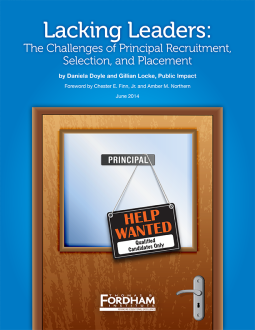By Daniela Doyle and Gillian Locke, Public Impact
Foreword By Chester E. Finn, Jr. and Amber M. Northern
A school’s leader matters enormously to its success and that of its students and teachers. But how well are U.S. districts identifying, recruiting, selecting, and placing the best possible candidates in principals’ offices? To what extent do their practices enable them to find and hire great school leaders? To what degree is the principal’s job itself designed to attract outstanding candidates?
In Lacking Leaders: The Challenges of Principal Recruitment, Selection, and Placement, authors Daniela Doyle and Gillian Locke examine five urban school districts that have sought to improve their principal-hiring processes in recent years. They find some strengths—but also plenty of challenges:
- The principalship is a high-pressure job in which the school head’s authority is generally not commensurate with his or her responsibility. It’s also a job that does not pay very well. Put these shortcomings together and it’s not surprising that many high-ability individuals are loath to seek such a position.
- Recruitment of leadership talent beyond a district’s own boundaries is limited and uneven. Most principals are therefore selected from a group of individuals already on the district payroll. While there is nothing inherently wrong with that, not much strategic thought goes into how to identify talent or find the best fit between the skillset of a new principal and the needs of a specific school.
- Districts have built into their selection-and-hiring processes many sensible practices—and cronyism is less of an issue than it used to be. Yet those same rubrics don’t collect much hard data on candidates’ prior effectiveness in improving student outcomes.
In the authors’ words,
Our primary finding is that principal-hiring practices—even in pioneering districts—continue to fall short of what is needed, effectively causing needy schools to lose out on leaders with the potential to be great. Our research suggests, however, that better hiring practices alone are only part of the solution. Districts must also re-imagine the principal’s role so that it is a job that talented leaders want and are equipped to execute successfully.
Among their key recommendations are the following:
- Make the job more appealing—and manageable. Give principals the power to lead, including authority over key staffing decisions, operations, and resources.
- Pay great leaders what they are worth. Compensation must be commensurate with the demands, responsibilities, and risks of the job—and should reward success in this challenging role.
- Take a proactive approach to recruitment. Develop criteria to identify promising candidates both inside and outside of the district and actively seek them out. At the same time, identify and prepare internal candidates systematically and early—and eliminate barriers that might discourage high-potential candidates.
- Insist on evidence of a candidate’s prior success in boosting pupil achievement.
- Evaluate candidates against the competencies and skills demonstrated by successful principals.
- Design the placement process to match individual schools’ needs with particular candidates’ strengths.
- Continually evaluate hiring efforts. Collect and analyze all relevant data, and then develop metrics by which to assess each stage of the process, particularly in relation to the school results that follow.
Register for the July 31 event 'Steering great leaders into the principal's office'
INFOGRAPHIC
On a mobile device? View the Lacking Leaders infographic.
____________
If you have questions about the book, please email Dara Zeehandelaar.



